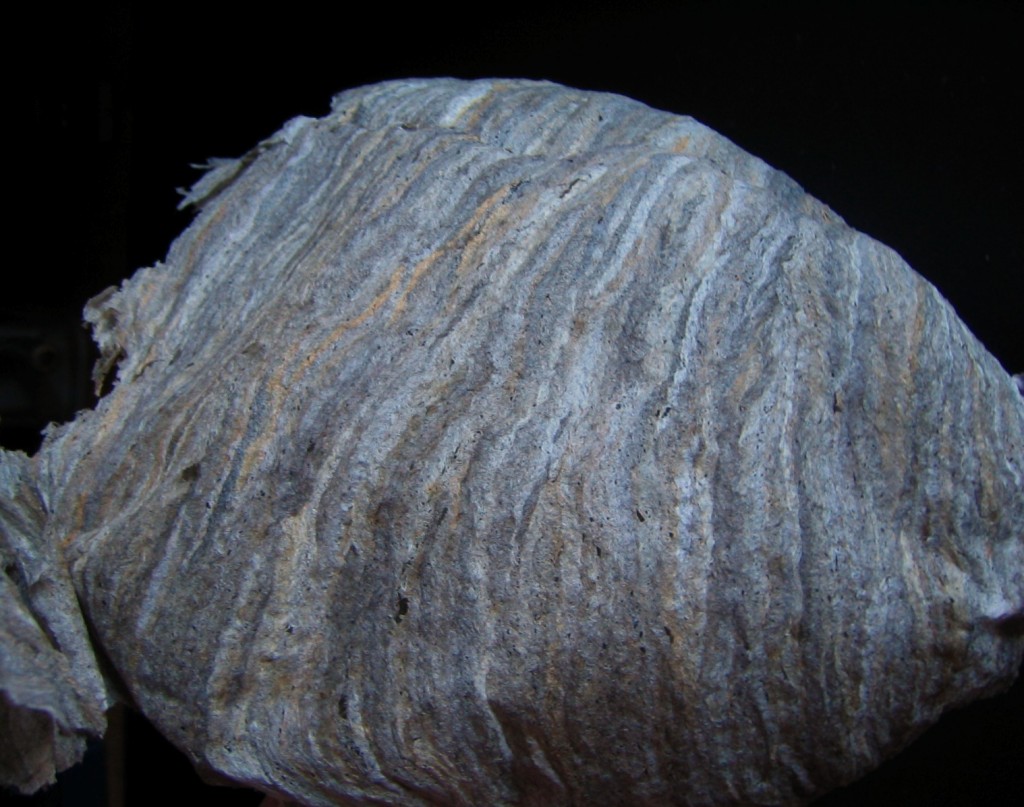The paper orb was lying on the sidewalk just a few steps from our house. I bent to pick it up. Its texture was of the finest Japanese papers–soft and strong, the waves across its surface as delicate as the finest wash of watercolor.

But what was it?
Some Googling led me to yellow jackets and their waspy relations, genus Dolichovespula. (Unfortunately, so many websites focus on exterminating yellow jackets that it can be tricky to find reliable—and friendly—information about their nests.)
While many yellow jackets nest underground, the aerial yellow jackets and their cousins the bald-faced hornets build similar paper nests. They chew wood fibers into a pulp and apply the pulp to the existing structure so that the nest expands over the summer to the size of a basketball. One nest may house thousands of workers and one or more queens.
The inside of the paper structure is even more enticing:
 Yellow jackets can be pesky when you’re at a picnic in late summer. They are frantic to feed the thousands of larvae newly hatched from their eggs. I usually set a small bite of meat to one side and direct the yellow jackets there, and soon they are all busily tearing up the strands of meat and carrying them off to the nest. Last summer I watched a piece of salmon nearly an inch long and a quarter-inch wide get transported in tiny bites completely away over the course of dinner.
Yellow jackets can be pesky when you’re at a picnic in late summer. They are frantic to feed the thousands of larvae newly hatched from their eggs. I usually set a small bite of meat to one side and direct the yellow jackets there, and soon they are all busily tearing up the strands of meat and carrying them off to the nest. Last summer I watched a piece of salmon nearly an inch long and a quarter-inch wide get transported in tiny bites completely away over the course of dinner.
Today I took my camera out to the tree to find the other remnants of the nest. There they were, shining in the early morning light. The core of hexagonal cells still hangs near the top of the tree while the rest of the paper shell has slipped away:

A nest begins in the early spring when a queen wakes up from her winter slumber and builds the first cells, a core about the size of a golf ball, and fills them with eggs. She tends the newly hatched until they are grown and can take over looking after babies. A community may grow to several thousand over the summer, including a few new queens.
With the first frost, the nest begins to disintegrate and the workers to die off. Only the fertilized queens will survive over the winter, hibernating to begin the cycle again in the spring. That’s an awful lot of work to put into a house, and a community, that lasts only one season!
Yellow jackets are beneficial to your environment. They eat lots of houseflies and other insects, and they are known to pollinate squash and milkweed. Don’t exterminate a nest just because it is there. Good-neighbor policy applies: peace is possible when everyone minds their own business and leaves a little room for others to mind theirs.
Appreciation is also good policy. Every species makes a contribution to the life of the world, and thanking them for their work can be a fine and friendly practice.
This is so beautiful. I paint watercolors and wish we made houses in beautiful colors like this.
Absolutely lovely. I appreciate so much how you seem to just “happen upon” the miraculous and share it with us.
It certainly is a beautiful house, isn’t it? Or rather, was. Another feature of it that I enjoy is that it decomposes when its inhabitants are gone–back to the earth to be integrated into the elements with barely a rustle to mark its going. If only our houses were so earth friendly.
Some new miracle everywhere we look. I love finding the surprises in urban and suburban environments.
Beautiful words and pictures of a beautiful part of nature that we too commonly overlook. Thanks for encouraging us to stop and appreciate.